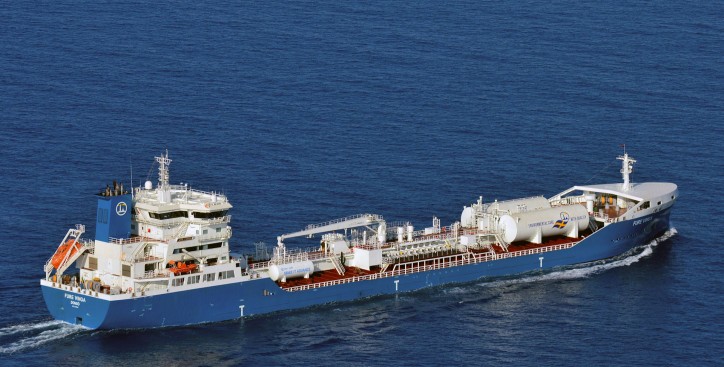Skangas have supplied the leading Swedish shipping company and LNG pioneer Furetank with Liquefied Biogas (LBG) - a renewable and environmentally friendly fuel. The Swedish LBG was delivered to Furetank’s M/T FURE VINGA from Skangas’ parent company Gasum’s biogas facility in Lidköping. The fueling took place at the port of Gothenburg, transferring the fuel directly from a tanker truck to the ship.

The FURE VINGA was delivered from the shipyard in April this year and is one of two vessels in the company’s fleet powered by liquefied gas. Furetank has been using LNG as fuel since 2015 when the FURE WEST was converted for dual-fuel.
Expanding the LNG vessels
Together with partners Furetank is building five further sister vessels to the FURE VINGA, all of which will be dual-fuel and can be powered by LBG when the fuel is available. The vessels will be trading in North Europe and will benefit from Skangas’ LNG supply network in the region. Skangas is already supporting Furetank’s other LNG-fueled vessels in ports and at sea
Sustainable and interchangeable alternative fuel
Further to the environmental benefits of using LNG instead of conventional bunker oils LBG is also 100% renewable with no CO2 emissions. For running the engine LBG has similar or better characteristics compared with LNG.
“Running vessels on liquefied natural gas is our contribution to a more environmentally friendly environment. We will, however, contribute by increasing the sustainability. Using liquefied biogas was a natural step in this direction,” explains Lars Höglund, CEO of Furetank. “No doubt LBG will be a clear option for us. It is proven by this operation that it can be available from our existing LNG supplier and not at least with the same quality as our current LNG fuel”, he concludes.
“This is the first time we are supplying LBG to a marine customer. However, it will not be the last”, says Tommy Mattila, sales and marketing director in Skangas. “To be increasingly greener with the renewable biogas is possible because we use the same infrastructure that we’ve built throughout northern Europe. This mean that LNG and LBG will continue to walk hand in hand as the availability of LBG on the market is on the rise.”
Because the LNG and LBG mainly consist of methane gas the existing LNG supply infrastructure can be used without any modifications. This means that you use the same trucks, ships, tanks and marine filling stations for both products.
LNG is the cleanest available marine fuel, one that is rapidly becoming more commonly used as a cost-effective alternative. LNG is suitable for all vessel types, including ferries, passenger ships, tankers, bulk, supply and containerships. LNG offers several benefits by reducing local and global pollution. Switching to LNG completely removes SOx and particulates and reduces NOx emissions by up to 85%. In addition, LNG reduces CO2 emissions by at least 20%. Use of LNG as marine fuel result in compliance with current and forthcoming IMO and EU regulations. Skangas expects the LNG demand for ships to increase significantly in next few years as responsible shipping companies are seeking cleaner fuel alternatives.
Liquefied biogas (LBG) is similar to liquefied natural gas (LNG). LBG is a renewable and environmentally friendly fuel made from 100% local feedstocks. Firstly, biogas is produced through the processing of various types of organic waste. Secondly, the gas is purified and upgraded to approximately 97% methane. This process takes place in Skangas’s parent company Gasum’s biogas facility in Lidköping. The biogas is further being liquefied by cooling it to a temperature of minus 160 °C for transportation by trucks to customers.
Source: Skangas